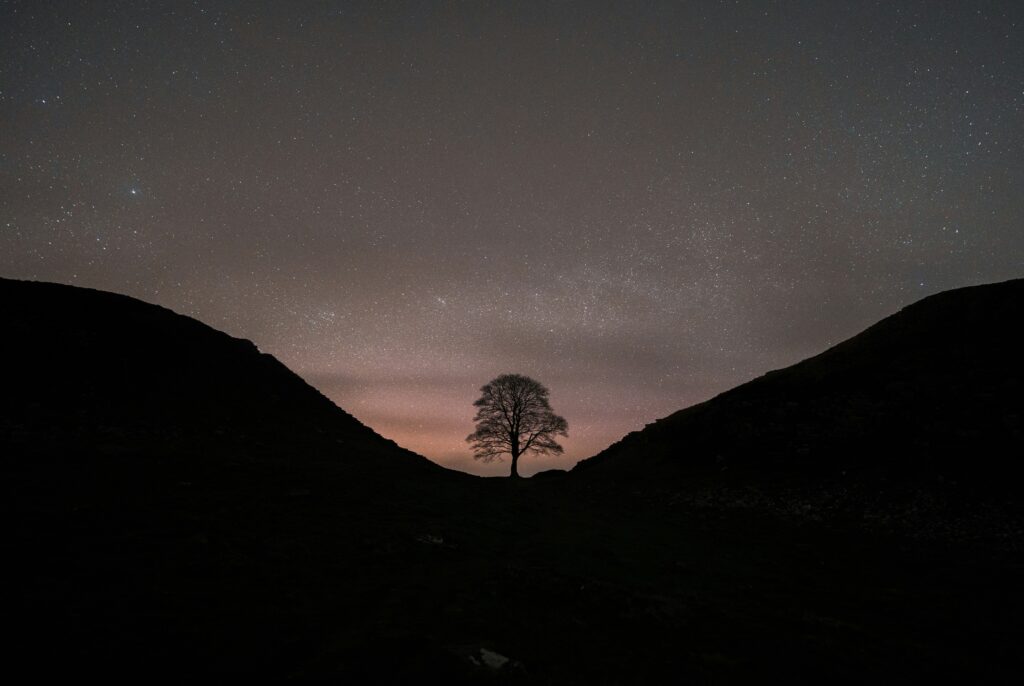This Easter, we heard Newcastleʼs Bishop Helen-Ann give the Good Friday meditation on BBC Radio 4: reflections arising from the felling of the tree at the Sycamore Gap which, for three hundred years, grew beside Hadrianʼs Wall, in a dip that framed it, showing it off in its magnificence. It had become a space that drew people to it: to plight their troth, to scatter the ashes of their loved ones, or simply to marvel and wonder. Famously, Kevin Costner filmed a scene there in his 1991 film about Robin Hood. Last September, the much-loved sycamore was deliberately felled. It is not known by whom.
Shock, grief and condemnation followed. The question Why would anyone do this? has been asked repeatedly. There seems no answer. And yet, there must have been a clear and deliberate motive. Itʼs not easy to cut down a huge tree. Whoever did it, planned it, and had the ability to carry it out.
I found myself thinking back to the planes that flew into the twin towers of the World Trade Centre back in 2001. An act of extreme violence, expressing condemnation of Western capitalism. If there was any message in the felling of the sycamore, it was harder to read. But we may reflect that beautiful trees are felled daily. That this goes on routinely, without the outrage stimulated by the loss of a tree that has captured the imagination of thousands.
In her meditation, Bishop Helen-Ann did not seek to read meaning into the motive for the felling, but rather to draw meaning from heart-felt and creative responses to loss. She took us to Newcastle Cathedral, and the Storytelling Chair in the crypt, crafted from an oak that came down in a storm. This chair was made in response to women who, having suffered, had found healing in telling their stories before compassionate witnesses. It was crafted in keeping with their requests. The women wanted the chair to reflect the interweaving of the shards of their stories. And to have a firm, substantial seat to support whoever plucks up courage to take the Storytelling Chair.
The tree of the Sycamore Gap has been cut down, but not killed. Today a notice stands beside it to that effect. If left to heal, it has the potential to shoot and re-grow. All the worldʼs stories are about the interplay of opposing tendencies: the tendency to create, construct, grow, and the tendency to destroy. The Easter story is an archetypal example. Its protagonist, who had become known for challenging hypocrisy and standing up for the underdog, changes. One day he is angry, overturning the money-dealers tables in the Temple, opposing the greed they represent. But then, at the culmination of the story, he stops. No more words. No more actions. A surrender. An allowing. But not a compromise. Rather, a conscious acknowledgement of inevitable outcomes. By surrendering to those outcomes, in some way he enters right into them. And the story tells us that this entering changes the way things are—not on the outer, but on the inner. It brings about a new possibility for the one who walks that path.
I think of Fernando Meirelles’ outstanding 2019 film, The Two Popes, in which both Ratzinger and Bergoglio, who became Popes Benedict and Frances, are also shown to change, radically, at pivotal points in their lives. In this film Benedict initially resists change, dismissing it as compromise; through the course of his profound exchange with Bergoglio, he learns to look upon things differently. The Easter story of crucifixion and resurrection acknowledges that there is a time for protest and opposition. But it moves on from there. It places the focus on a time for transformation. It is a story about transcending evil and pain through entering right into it without being spiritually corrupted by it.
In his short 1929 film, Un Chien Andalou, (An Andalusian Dog) Luis Bunuel depicted a dogsʼ home. But however many dogs were rescued, the problem of stray dogs remained, for there was always another. There will always be evils in the world. Some arise from greed, and the desire for power and control. Others, from carelessness or mischance. (Over the week-end we happened upon an account of the only time Concorde crashed, causing 113 fatalities—because of a piece of metal that had dropped, un-noticed, off the previous plane that took off from the same runway.) Some evils defy categorisation. The Easter story starts in the everyday world of time and space, where bad things inevitably happen. Then it moves into another dimension: one that can only be reached through a kind of surrender that is not compromise.
We went through the days of Easter with all its dynamic of sorrow and joy. We rose on Easter Sunday to see a most beautiful dawn breaking over the hill that rises behind our house: pink clouds stretching out under a pellucid pale blue sky. And, after an eggy breakfast, we set off to join the 600 worshippers gathered in St Davidʼs Cathedral. We were seated near the entrance, and so—all through the service—saw people arrive, stop, stare and slip out again. It probably hadnʼt occurred to most of those brief visitors that a service would be going on. Like my young relatives, who thought it would be nice to go to Rome in late March, and booked the last week-end, with no thought that thousands would celebrating Easter there. “Weʼll steer clear of the Vatican,” they announced, when this was pointed out to them. But what they couldnʼt steer clear of was the procession that wound through the ancient city from the Colisseum, honouring the lives of the martyrs. (The very people noted for having the courage to face evil and surrender without compromise.) We couldnʼt help but smile.
Gillian PB
April 2024
Gillian runs Pantolwen Press, a small independent publishing house.
Recent publications: The Seaborne andThe Priest’s Wife by A G Rivett—first books of the Isle Fincara Trilogy


